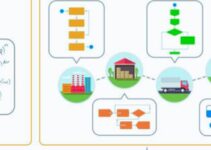Supply Chain consists of information, resources, activities, and people that play a key role in transforming raw materials into final goods and products. The SCM comprises various activities and processes like the production and manufacturing of material, storing and transferring of goods, and delivering the finished goods to the end consumers. Today, we’ll discuss understanding supply chain management; various roles, and key elements involved in the SCM process.
What is Understanding Supply Chain Management?
Supply chain management is the method of managing various processes of converting raw materials into finished products and goods. People won’t have access to food and health supplies without a supply chain, or the items that would help you to travel and work. SCM is the network of vendors and suppliers connected with the help of a centralized management system. Every vendor and supplier serve as a main link that would move the goods along the chain of production; ranging from raw suppliers to producers and retailer.
The process of SCM used to be very rigid in the past, every stage in the SCM process moves in sequence and it allows you to move product from raw supplies to the end consumer. Various events of disruptions point out the significance of flexibility in the SC process.
Roles of SCM
Some of the main roles involved in the supply chain management process are as follows;
Material Processors
It consists of those businesses and companies that process raw supplies like wood, rubber, metal, and other natural resources.
Producer or Manufacturer
Businesses and companies develop goods and products for sale by converting raw supplies into finished goods for the end consumers. It is significant to mention here that not all SC channels develop physical products. For instance, different energy-producing companies employ raw supplies like coal, wood, and oil to produce energy for the end consumers.
Vendors
They also go by the name of sellers, and they sell goods to the next party in the SC channel. Some of the manufacturers and producers also fall under the category of vendors.
Warehouses
After the sale of the goods and products, they require storage. The location of the warehouses and storage facilities is in the main hubs. The parties involved in the SC process could buy it from them and deliver it to the distribution centers.
Transportation Companies
Some of the main examples of transportation companies are trucking companies, container ships, and freighters. When goods and products reach the next location and site, their objective is to deliver them to the retailers.
Distribution Centers
Distribution points are the regional facilities and they store the goods for further redistribution to the wholesalers, retailers, or end consumers in some cases. Usually, distribution centers have got refrigeration to preserve the perishable goods.
Retailers
They are at the end of the SC process and they sell goods and products directly to the end consumers via online, stores, or shopping centers.
Process of SCM – Elements
Some of the main elements in the process of supply chain management are as follows;
Planning
The SCM process starts with planning, companies should plan what and how they should function and operate. For instance, if you are running a business of children’s toys, then the owner should decide whether they would buy toys from the production facility, manufacture the component, or buy components from the suppliers. The SC planning stage comprises of following activities;
- Organizing and designing the warehouse of the company
- Dealing with manufacturing and storage facility
- Making sure efficient transportation of goods in different sites
- Establishing KPIs (key performance indicators)
- Gathering data from the market
- Tracking and analyzing the productivity
Businesses and companies streamline their SC process with their business model to make sure coordination among various parties within the same network. It helps you to monitor and analyze the effectiveness of the strategies.
Receiving Goods
After planning your business and deciding on your suppliers, it is significant to sign the contract and discuss the terms and conditions, delivery schedule, and payment method. Businesses and companies should make sure of an open communication channel with all the suppliers, maintaining and tracking inventory to keep the stock level up.
Manufacturing & Production
As the name implies, it is the stage where companies manufacture, test, and assemble the finished goods and deliver them to the end consumers. In order to make sure that the companies satisfy the manufacturing objectives, they should analyze the sales and employee performance. It helps them to make necessary adjustments at the production level and make employee schedules.
Product Delivery
Along with transporting and distributing the finished products and goods to the end consumers, it comprises answering questions that the customers have about the product or good. Companies should manage their inventory to make sure the following;
- Organizing products in the warehouse
- Appropriately storing them
- Analyzing to avoid obsolescence
Processing Returns
While managing the defective products, it is significant to manage and process the returned goods. Employees should keep in mind the following;
- Recognize the conditions of its items and flaws
- Authorizing customer returns
- Processing refunds
- Replacing obsolete items
- Allowing better customer service
- Improved customer relationship management
Conclusion: Understanding Supply Chain Management
After an in-depth study of understanding supply chain management; we have realized that SCM plays a key role in the company’s operations. If you are learning about the SCM processes, then you should keep in mind the abovementioned elements and roles.
Ahsan is an accomplished researcher and has a deep insight in worldly life affairs. He goes Live 3 days a week on various social media platforms. Other than research writing, he’s a very interesting person.


